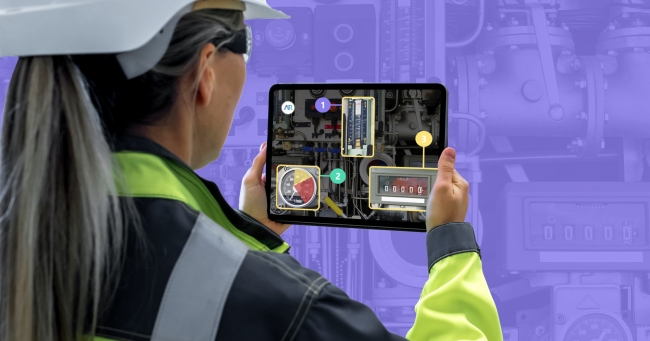Topics
How the Pandemic Brought AR to Service Operations

As with so many of the ways that we’ve become accustomed to interacting during the pandemic, service operations now fall under the domain of “tele-everything.” This shift toward the remote—ranging from touchless B2C technical support to remote expert assistance for B2B field service technicians—is here to stay as we (hopefully) move toward the pandemic’s tail end.
Businesses now realize that technology-enhanced remote service operations offer numerous benefits besides health and safety. The new paradigm of service operations is more efficient, less costly, boasts a greater percentage of first-time fix rates and requires less travel than before.
Augmented reality (AR) is a key enabler for this movement. Using a combination of guidance through digital overlays and giving remote experts eyes on the ground, AR opens new possibilities for streamlining and improving service operations.
AR Tech Support
What began with a hesitance to welcome strangers into one’s home, contactless tech support is now the standard for most businesses. By developing AR apps that run on smartphones without any special hardware, companies ranging from appliance manufacturers to those that provide the home networking equipment so critical to today’s remote workforce are realizing significant return on investment (ROI).
For example, home appliances—such as washing machines , dishwashers and refrigerators—are often complicated to troubleshoot and repair. By using AR as a “digital user’s manual,” customers gain the power to troubleshoot and clear simple issues related to their appliances with confidence.
That’s why when CGS surveyed 140 operations executives at leading companies for our Accelerating Digital Transformation in the Next Normal report, we discovered a clear trend for these B2C AR use cases. At the forefront, nearly 40 percent of respondents point to boosted first-time fix rates as one of the top three benefits of AR and mixed reality (MR), and more than 50 percent say that improved first-time fix rates are the biggest benefit for incorporating AR into customer-facing technical support. Since 60 percent agree that first-time problem solving is a top customer expectation when it comes to technical support, companies that can effectively leverage AR to this end will reap the rewards of improved customer satisfaction, loyalty and word-of-mouth recommendations.
Another clear trend we see is how AR reduces cost of service; 50 percent see this as the biggest benefit. It’s clear how reducing travel costs, repeat support tickets and the amount of time that customer support agents spend on each case has a tangible effect on the bottom line.
Third, AR also helps new employees get up to speed. Since 50 percent of operational leaders cited reduced training time as the biggest benefit to adopting AR, it’s clear that organizations are saving money by reducing on-boarding time while simultaneously producing more competent technicians by providing them with experiential, hands-on learning.
By leveraging AR for B2C service operations, companies meet their customers’ expectations of first-time fixes and contactless support while also saving money and creating efficiencies. Pandemic or not, that’s more than enough reason to justify the continued investment that we’re seeing in this tech.
Remote Expert Assistance
AR is also revolutionizing B2B service operations. Technicians on the plant floor or even in the most geographically remote locations can instantly and seamlessly communicate with remote subject matter experts (SMEs). The SME can then see exactly what the technician is dealing with while also providing visual instructions. Instead of trying to talk through what screw to remove or sequence to follow, for instance, a seasoned technician can simply circle it on a screen or annotate with arrows and text to avoid confusion.
In one use case, when Toshiba Global Commerce Solutions (TCGS) began using TeamworkAR™ to support its POS solutions, the company saw substantial gains in service time and a benefit to both service technicians and customers.
This story is part of a larger trend that we’re seeing across multiple verticals, and our survey results paint a clear picture of how businesses are applying AR/MR tech to their service operations. When we asked about the top three ways that these executives plan to apply this tech to their companies’ processes or service, they chose training and development (56 percent), remote diagnostics (44 percent), and repairs and maintenance (21 percent).
These use cases enable businesses to cut a number of costs while also improving service quality. That’s why 43 percent respond that increased employee productivity is a top benefit of AR, while 30 percent agree that extended expert reach made the list. On top of that, reduced travel time and its associated costs were a determining factor for 35 percent of the executives.
Only the Beginning
The pandemic may have changed service operations by placing a greater emphasis on health and safety, but that’s far from the only reason that companies large and small are adopting AR into their workflows. In our survey, 57 percent of operational leaders agree and 33 percent strongly agree that implementation of experiential technology like AR will help organizations gain a strategic/competitive advantage.
These advantages are fueling a new wave of investment into AR technologies. Nearly 78 percent of respondents claim that their organizations will increase or plan to increase their spending on AR technology in 2022 because of the pandemic, with around 15 percent planning on spending over 20 percent of their total tech budget on these innovative solutions.
What’s most exciting is that this is only the beginning. For more insights and actionable intelligence on operations leaders’ plans and investments for 2022, download the complete Operational Leaders 2022 Annual Tech Trends report.

